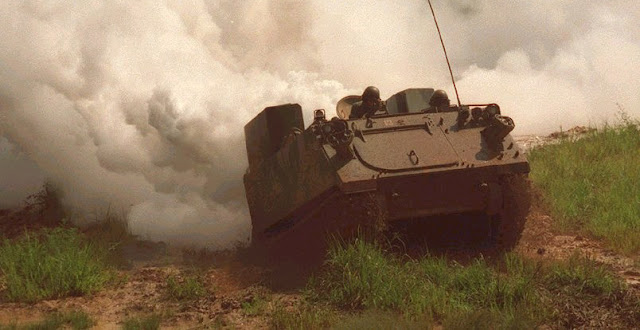When Smoking is a Good Thing
If you work at TARDEC (the Tank and Automotive Research Development Center) you pretty much spend all day thinking about how to increase the survivability of ground vehicles during combat operations.
In fact, the folks at TARDEC have created a nice metaphor to explain levels of survivability on the battlefield using none other than your garden variety onion. The metaphor works well when you consider that peeling back the layers of an onion, is not unlike the enemy peeling back your defense mechanisms in a ground vehicle. See the graphic below:

Falling somewhere between “Don’t Be Acquired” and “Don’t Be Hit” is the use of battlefield smoke generators. While not a new idea, these generators have grown in sophistication over many decades and are part of the defensive arsenal of many military vehicles in use today, particularly tanks. By deploying plumes of thick smoke, vehicle operators can obscure line of sight vulnerabilities. If enemy fire misses you as a result, well an inch can be as good as a mile.
Making Smoke Reliably Requires things to Get Hot.
To make smoke on a tank, a small amount of oil is dropped into the hot exhaust of the vehicle. As the oil burns, smoke will billow out the exhaust. The driver can then move in a random pattern to create a wider smokescreen, ultimately obscuring the movement of the vehicle. The oil based smoke is heavy and stays close to the ground for a period of time, which is critical to allowing the vehicle to get under cover.
CPI actually has long experience with this application, having provided thermal switches for the older M157 Smoke Generator designed used on variations of the HMMWV. This previous configuration of the Smoke Generator System used both a CPI M2 style thermal switch as well as our X2 style switches.
In the new system CPI X2 series high temperature thermal switches are used. These thermal switches will be mounted directly inside the engine exhaust and programmed to activate the oil injector system at 300F. But the military’s requirements don’t stop there. As the temperature in the smoking exhaust increases, the switch will then need to survive temperatures up to 1300F afterwards.
Our X2 series “Rod and Tube” thermal sensor is perfect for this application having an operating temperature range up to 1750F, and a design for high durability and survivability.

In our rod & tube thermal switch design, the outer tube expands at a faster rate than the inner rod allowing for movement of one set of a spring & contact assembly towards another set. Setpoint temperature is calibrated by position of the calibration screw which moves the position of the spring & contact assembly opposite of the moving contacts. Electrical circuit configuration is determined by use of insulators. In our MIL connector designs, the terminal screws are replaced with an inner pin and wire assembly that are connected to related terminals on the MIL connector.
Switch variations include close-on-rise, open-on-rise, and close-on-fall behavior to fit any system requirements.
For More information on this or any of our military grade switching products, please contact CPI’s Thermal Switch engineering team through our website at https://cpi-nj.com
Original content posted on https://www.cpi-nj.com/blog/when-smoking-is-a-good-thing/.
Switch variations include close-on-rise, open-on-rise, and close-on-fall behavior to fit any system requirements.
For More information on this or any of our military grade switching products, please contact CPI’s Thermal Switch engineering team through our website at https://cpi-nj.com
Original content posted on https://www.cpi-nj.com/blog/when-smoking-is-a-good-thing/.

Comments
Post a Comment